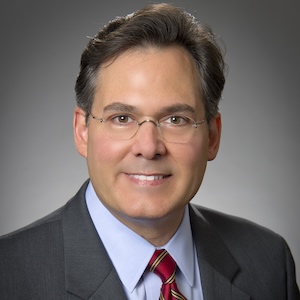
Spending more than four decades at the same company seems like an almost impossible feat these days, but David Bouffard is used to doing the near-impossible. During his 42 years at Signet Jewelers, he learned the basics of retailing, dealt with some pretty thorny controversies, and helped build groups such as the Responsible Jewellery Council (RJC). Through the tough times, he always believed what his mother taught him at a young age: “Never quit.”
After stepping down as Signet’s fellow of industry affairs and chairman of the RJC in May, Bouffard has formed David A. Bouffard Consulting. Based in White Plains, N.Y., the firm will advise companies on what Bouffard calls the new 4Cs: culture, compliance, consumer confidence, and corporate social responsibility.
Here, he gives JCK the inside story on how a regional chain became America’s top jeweler, shares memories of industry titans like Nate Light and Terry Burman, and speaks frankly about why he believes there are too many industry organizations.
Tell me about your background.
I grew up in northern Connecticut. My father was an ironworker during the insurance industry’s building boom in Hartford. I was the second of seven kids, the first in my family to go to college.
In 1981, I was a premed student attending college in Philadelphia. To help pay for school, I answered a job ad for a salesperson at Gimbels department store. The job was actually working for a leased jewelry department operator called Marcus & Company, owned by Kay Jewelers.
I started in field operations and was sent to learn from the area’s training manager in King of Prussia, Pennsylvania. We’ve been married for 41 years.
How did your career progress from there?
In 1986, Marcus’ CEO, Harry Braverman, visited Philadelphia from New York. I went up to him, and like a babbly immature twentysomething, I rambled on that I dreamed of working in New York City. He listened to me and said three words that changed my life: “Be there tomorrow.”
Eventually I was promoted to director of department store sales, managing 85 stores across the country. It was there that I learned merchandising and advertising, while working in New York City—my dream fulfilled.
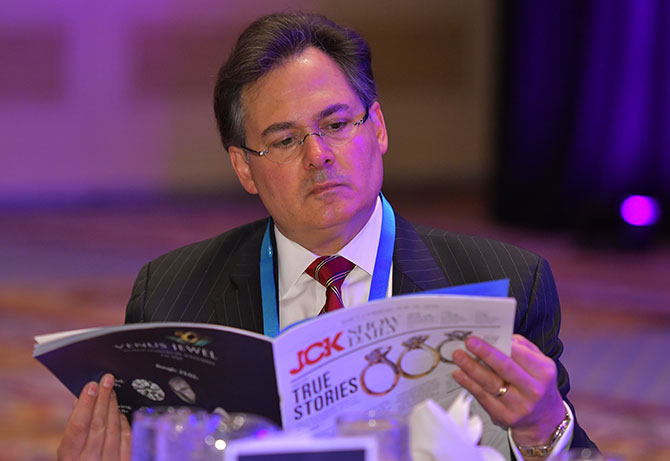
And how did that bring you to Signet?
By the 1980s, things were changing in our industry. Sterling Jewelers was a regional family-run chain, one of many. Jerry Shaw had taken over its operations from his father, Henry. After World War II, he built freestanding stores in small cities along the Great Lakes region, following the population growth of the auto industry. When malls started to appear, they were not Jerry’s expertise. He needed someone who knew how to run mall-based stores. In 1977, he brought in Nate Light.
In the early 1980s, Jerry was thinking of retiring. Boston Consulting Group found an investor in Gerald Ratner [head of Ratner Group in the United Kingdom]. Nate and Gerald saw the industry in a way no one else did. They drove innovation in product and pricing and purchased various family chains. Their goal was 1,000 stores in the United States. By 1990, they had reached that, when they purchased Kay Jewelers.
That was how I met Nate Light. Nate wasn’t that familiar with the department store businesses, but Marcus was profitable. In January 1994, he came to our offices in New York and told me I was moving to Akron, Ohio, that spring. We lived there for 30 years.
What did you learn from Nate?
A lot. Nate’s management style involved a lot of walking around and talking to people. He said you learned the most by listening to vendors and staff, especially salespeople. He always said, “We’re a people company that happens to sell jewelry.” You had to be a person that cared, and you needed a strong culture focused on the team.
He recognized that Sterling’s growth would position it as an industry leader, and with that, came a new kind of responsibility. After JCK premiered in Las Vegas, he and Clyde Duneier spearheaded an industry charity gala called “Party With A Purpose.” That would later become Jewelers for Children.
Then there was a big issue with Gerald Ratner…
Gerald operated about 500 Ratners Jewellers. But he made some infamous remarks in 1992 [editor’s note: he called its merchandise “crap”] that put the company in peril. The board had to let him go. They wanted a company name that would symbolize and serve as a seal of quality—a signet. They also changed the name of Ratners stores to H. Samuel, after Harriet Samuel, the daughter-in-law of the founder.
Tell me about Terry Burman.
Terry and Nate were two great men. You couldn’t ask for two more different people and business styles, but they both had vision and lasting impact. Nate was all about building up store count and being the biggest and the best. He was more top-line focused.
Terry was more bottom-line focused. He used his financial acumen to turn the company around. He brought discipline and structure into the organization. In 1995, he was named CEO of Sterling. By 1998, we’d reached $1 billion in revenue for the first time.
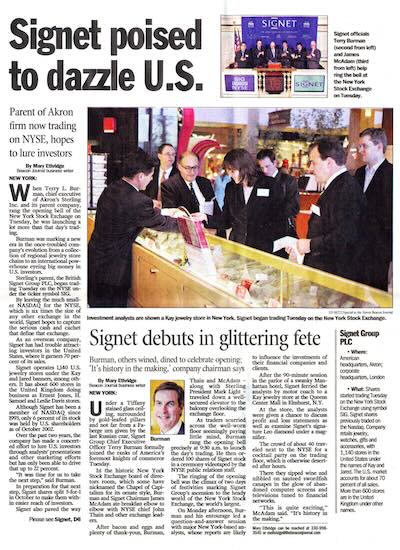
At what point did Signet become the biggest jeweler in the industry, leapfrogging Zales?
After all its 1980s acquisitions, Sterling operated more than 20 regional store names, each supported by local radio advertising. In 1992, Nate hired a genius named George Murray, who’d worked on ad campaigns for Chiquita bananas, Perdue chicken, and others. His background was essentially branded commodities. Nate wanted a national brand with national television advertising. That was blasphemous at the time. In our industry, local has always meant a lot.
When Terry arrived, the idea of creating a national brand was already underway, but he put it into first gear. After we proved the concept on television, most of the regional store brands were converted to Kay Jewelers.
We had other advantages, like our own credit department, which we managed successfully for over 30 years. Our merchandising, marketing, and store operations teams were highly collaborative, with everyone moving in lockstep. We had a satellite system, called VSAT, that had real-time reporting of sales of every SKU, every day. That gave us a competitive advantage in terms of inventory planning, well before today’s widespread adoption of computerized inventory management.
When I was a senior buyer at Jared, the executive vice president was Joe Freedman, who was essentially the number two behind Nate. He taught me not to buy items but to buy programs. He taught everyone to focus on styles that told a story, with a more consistent and structured approach.
Bill Montalto Sr., who joined Sterling from Coopers & Lybrand, built Sterling’s information center and other key functions. I used to call him “the architect.” By 1989, he essentially turned a former 34-acre farm in West Akron into our current state-of-the-art campus, in anticipation of Nate’s vision of us becoming the largest jeweler in the United States.
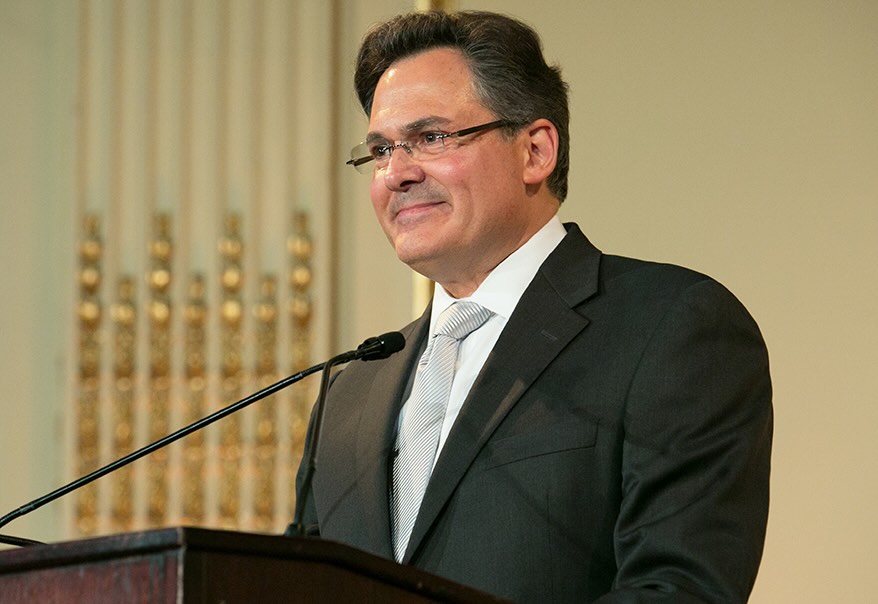
Most of your job recently was dealing with social issues. What was the start of your involvement with that?
Terry became Sterling CEO in 1995, and Matt Runci became CEO of Jewelers of America that same year. When Global Witness coined the phrase “blood diamond” in 1998, Terry and Matt knew that had to be addressed. They became a force pushing continuous improvement in the global supply chain. That is what we at Signet have worked on for the last 25 years.
In 2005, we formed the Responsible Jewellery Council. At first it had 14 founding members. It’s now approaching 1,800 members and become embedded in the industry as the only ISEAL-approved standards and certification organization.
We now live in a world of compliance. To have ethical business practices today, that’s table stakes. I believe every retailer should be an RJC member.
Within a short time frame, the industry had developed Jewelers for Children, the World Diamond Council, the RJC, and Diamonds Do Good. Today I believe the industry is hampered by too many competing associations and groups. That’s led to fragmentation, competition for limited funding, redundant dinners, and the same people serving on different boards.
The organizations’ voices have gotten lost in an industry echo chamber, while consumers largely remain unaware of the good the industry does. I’d love to be part of a team that could help bring all the nonprofits together under one roof, which would offer a strong menu of programs for retailers and suppliers and then tell its story to consumers. This may be controversial, but think of the efficiencies it will bring.
Any final thoughts?
At an RJC celebration in April, I was asked what I’m most proud of. I thought of three things: my family, the RJC, and Signet’s commitment to St. Jude Children’s Research Hospital. Over 25 years, Signet has raised $100 million for St. Jude.
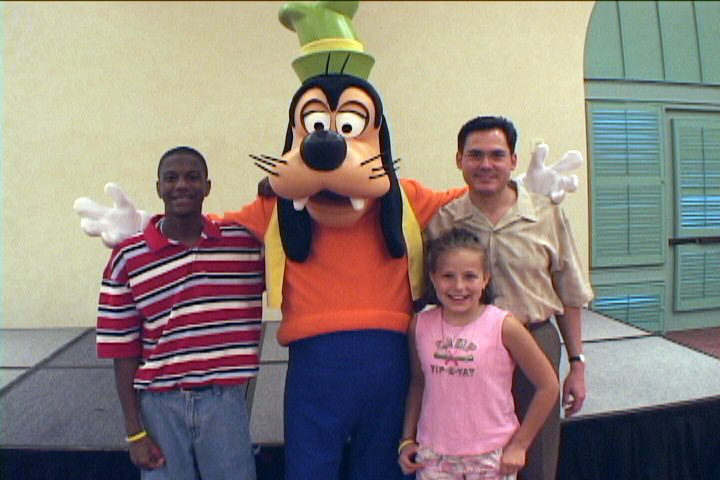
When I was a teenager, there was an American Express commercial and it showed a guy landing in a plane in the dark, getting into a hotel very late at night, and calling Amex to deal with some crisis. I thought, I’d like to be that guy someday. That eventually happened, but not in a linear way.
Looking back, I’ve had a remarkable career with experiences beyond my dreams. I’ve been blessed with a loving, supportive, and understanding family.
I was fortunate to learn from extraordinary mentors, people who took a chance on me. I’m extremely grateful to them.
(Top, Akron paper, and St. Jude photos courtesy of David A. Bouffard Consulting)
- Subscribe to the JCK News Daily
- Subscribe to the JCK Special Report
- Follow JCK on Instagram: @jckmagazine
- Follow JCK on X: @jckmagazine
- Follow JCK on Facebook: @jckmagazine







